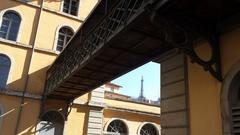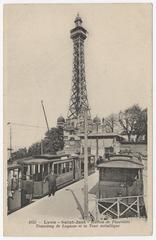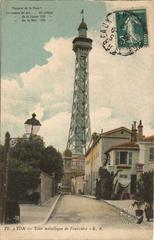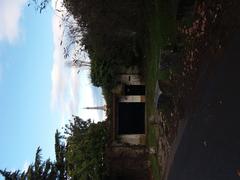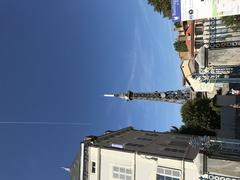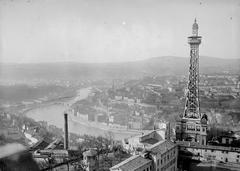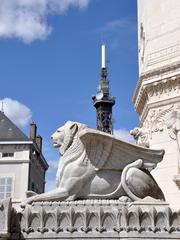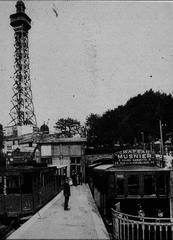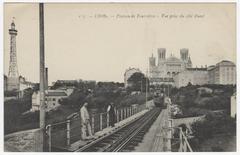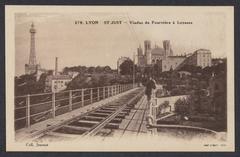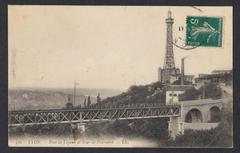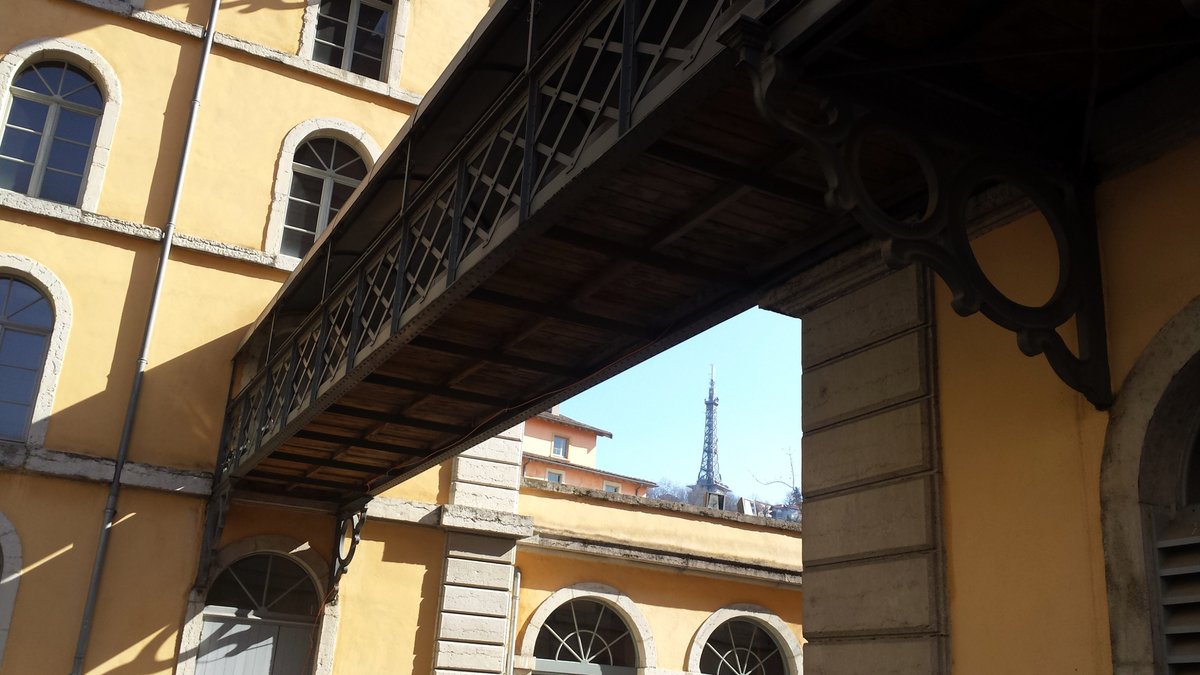
Metallic Tower of Fourvière, Lyon, France: Visiting Hours, Tickets, and Comprehensive Guide
Date: 15/06/2025
Introduction
Perched atop Lyon’s iconic Fourvière Hill, the Metallic Tower of Fourvière (Tour métallique de Fourvière) stands as a testament to the city’s industrial ambition and rich cultural heritage. Often called Lyon’s “Eiffel Tower” for its resemblance to Paris’s architectural marvel, this iron lattice structure has witnessed over a century of transformation, serving both as a symbol of modernity and as a practical telecommunications hub. Although interior access has been closed since 1953, the tower remains a must-see landmark—offering breathtaking views from its surroundings, a unique historical narrative, and a central role in Lyon’s UNESCO World Heritage landscape (France Travel Tips, Wanderlog, en.visiterlyon.com).
This guide details the tower’s origins, significance, architectural features, practical visiting tips, and the best ways to experience its grandeur, even without ascending it. Whether you’re passionate about architecture, history, or panoramic photography, here’s everything you need to know for a memorable visit to the Metallic Tower of Fourvière.
Table of Contents
- Introduction
- Historical Overview
- Visiting Today
- Practical Visitor Information
- Nearby Attractions and Guided Tours
- Cultural Significance
- Tips for a Memorable Visit
- Frequently Asked Questions
- Summary & Recommendations
- References
Historical Overview
Construction and Symbolism
The Metallic Tower of Fourvière was built between 1892 and 1894 by the Société Anonyme de la Tour de Fourvière, inspired by the success of the Eiffel Tower in Paris. Its creation coincided with the 1894 Lyon Universal Exposition, aiming to position Lyon at the forefront of technological and architectural progress. The tower’s location—on land donated by the influential Gay family—was strategic: not only does it dominate the city skyline, but it also symbolically rises above the neighboring Basilica of Notre-Dame de Fourvière, reflecting a secular counterpoint during a period of religious and republican tension.
Architectural Features
Standing 85.9 meters (282 feet) without its antenna, and reaching a total height of 101 meters with the broadcasting mast, the tower is Lyon’s highest point, especially when combined with the altitude of Fourvière Hill (372 meters above sea level). The structure comprises over 2,100 iron trusses anchored in 7,200 tons of masonry, weighing in at approximately 210 tons. Its design closely mimics the third floor of the Eiffel Tower, with a square base, four iron legs, and a tapering shaft.
Originally, the base included a pavilion with a restaurant, entrance hall, and waiting room. A hydraulic elevator, then a technological novelty, transported visitors to the observation platform 80 meters above ground, offering sweeping vistas of the city and Rhône-Alpes region (Wanderlog, France Travel Tips).
Cultural and Political Context
The tower’s construction was a statement of Lyon’s modernity and a tangible expression of republican ideals. Deliberately positioned to rival the spiritual dominance of the Basilica, it embodied the city’s aspirations during a period marked by industrial growth and social change. While direct municipal funding remains uncertain, the project’s ambition and symbolism were clear: Lyon was staking its claim as a city of progress and innovation.
Visiting the Metallic Tower of Fourvière Today
Current Status and Access
Since 1953, the Metallic Tower has been closed to the public interior and no longer functions as an observation deck or restaurant. It is now used exclusively as a telecommunications tower, vital for radio and television broadcasts across the region (en.visiterlyon.com). Consequently, there are no visiting hours or tickets for interior access. However, the tower remains a focal point for visitors, who can enjoy its impressive exterior and panoramic surroundings.
How to Experience the Tower
- Viewpoints: The best views of the tower are from the Basilica’s esplanade, Parc des Hauteurs, Place Bellecour, the Croix-Rousse slopes, and along the Saône River.
- Photography: The tower is especially photogenic at sunset and during city events like the Fête des Lumières, when it’s dramatically illuminated.
- Guided Tours: Many city tours of Lyon include Fourvière Hill and provide insights into the tower’s history and significance.
- Nearby Attractions: The Basilica of Notre-Dame de Fourvière, Gallo-Roman Museum, and Ancient Roman Theatres are all within walking distance.
Practical Visitor Information
Getting There
- By Funicular: The most convenient route is via the Funiculaire de Lyon (Line F2) from Vieux Lyon – Cathédrale Saint-Jean station. The funicular is included in standard TCL metro tickets and runs every 5–10 minutes (nomads-travel-guide.com).
- On Foot: Walking up Fourvière Hill is rewarding but steep. Scenic routes include the Jardin du Rosaire and Parc des Hauteurs.
- By Bus: Several bus lines serve the area; check local schedules.
Accessibility
Lyon is recognized for its accessibility (en.visiterlyon.com). The funicular is wheelchair accessible, and there are accessible routes around the Basilica and Parc des Hauteurs. However, some paths are steep or cobbled.
Facilities and Amenities
- Restrooms: Available near the Basilica and public parks.
- Cafés: Several options near the Basilica; more in Vieux Lyon.
- Benches: Scattered throughout the parks for rest and enjoying the views.
Nearby Attractions and Guided Tours
- Basilica of Notre-Dame de Fourvière: Open daily; free entry, with access to the crypt and panoramic terrace for a small fee.
- Gallo-Roman Museum: Open Tuesday to Sunday (10:00 AM–6:00 PM); tickets required.
- Ancient Roman Theatres: Outdoor, accessible year-round with occasional events.
- Parc des Hauteurs: Gardens, walkways, and city viewpoints.
Guided walking tours frequently include the tower’s history as part of a broader exploration of Fourvière Hill (travelsetu.com).
Cultural Significance
The Metallic Tower of Fourvière is more than a feat of engineering. It’s a symbol of Lyon’s industrial past, its drive for innovation, and its unique blend of secular and sacred urban identity. Its presence during major events like the Fête des Lumières and its nightly illumination have cemented its place in Lyon’s collective memory (Wanderlog). The tower is protected as part of Lyon’s UNESCO World Heritage status, ensuring its preservation for generations to come (UNESCO).
Tips for a Memorable Visit
- Best Time: Early morning or late afternoon for the best light and fewer crowds; sunset is particularly beautiful.
- Seasonal Highlights: Winter offers unobstructed views; spring and summer feature lush gardens.
- Bring: Comfortable shoes, water, camera, weather-appropriate clothing.
- Nearby Eats: Try local specialties in Vieux Lyon after your visit, such as “Brioche aux pralines de St. Jean.”
Frequently Asked Questions
Q: Can I climb or enter the Metallic Tower?
A: No, the tower has been closed to the public since 1953 and is now used for broadcasting.
Q: Do I need a ticket to see the tower?
A: No tickets are required; exterior viewing is free and available at any time.
Q: How do I reach the tower?
A: Take the funicular from Vieux Lyon or walk up via scenic garden paths.
Q: Are guided tours available?
A: Yes, many city and historical walking tours include information about the tower and Fourvière Hill.
Q: What other attractions are nearby?
A: The Basilica of Notre-Dame de Fourvière, Gallo-Roman Museum, Ancient Theatres, and Parc des Hauteurs.
Summary & Recommendations
The Metallic Tower of Fourvière, though closed for interior visits, remains a powerful symbol of Lyon’s industrial heritage and urban identity. Its iron lattice silhouette, perched above the city, offers a dramatic counterpoint to the religious grandeur of the neighboring basilica. Access is limited to exterior viewing only, but the surrounding area—rich in history, gardens, and panoramic terraces—more than compensates. Plan your visit with the funicular for easy access, combine your tour with other UNESCO-listed sites, and capture the city’s best views from Fourvière Hill (Lyon Tourism, France Travel Tips).
For tailored recommendations and audio guides, consider downloading the Audiala app.
References
- France Travel Tips
- Wanderlog
- en.visiterlyon.com
- UNESCO
- travelsetu.com
- nomads-travel-guide.com
- happilyevertravels.com
